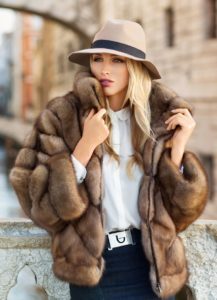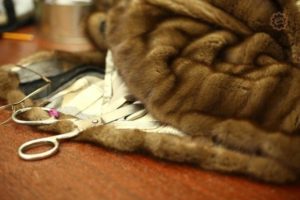 A fur coat is one of the most desirable wardrobe items for any woman. Some people prefer fur coats made from real fur, others from artificial ones.
A fur coat is one of the most desirable wardrobe items for any woman. Some people prefer fur coats made from real fur, others from artificial ones.
Let's look in detail at how to sew a fur coat from different materials.
What do you need to sew a fur coat with your own hands?
The main thing is material for work:
- Natural fur can be purchased in specialized stores or from hunters in the form of separate skins. Working with this material requires certain specialized knowledge and is one of the most difficult areas in sewing.

- Artificial fur can be found in almost any fabric store. Working with it is much easier than with its natural analogue. This material is much cheaper in price, and it is not so scary to spoil it; it is sold in the form of a single piece, like regular fabric.
- Old fur fabrics, for example, in the form of a fur coat and vest, which can be converted into a new fur coat.In this case, you need to understand that if there are abrasions and unsightly places on the material, they will have to be removed.
- Lining material. Satin or satin is often used as a lining for a fur coat; they are usually inexpensive. The product is given a rich look due to its smooth shiny surface, and these materials are very wear-resistant and retain their shape well during use.
 In addition to the material itself, to create a fur coat with your own hands you will need the following equipment:
In addition to the material itself, to create a fur coat with your own hands you will need the following equipment:
- Tailor's sharpened scissors or furrier's knife, the second option is preferable when working with natural fur.
- Clothespins are also needed for working with natural fur.
- Hammer with a soft silicone head or wrapped in cloth.
- Chalk, soap or gel ballpoint pen in a bright color.
- Metal long ruler.
- Safety pins.
- Small nails (when working with natural fur).
- Tape measure.
- A punch for installing accessories and attachments for it.
- Furrier's needles for machines, having three edges or gypsy needles.
- Comb.
- Thimble.
- The fittings are decorative and functional.

How to calculate the required footage for a fur coat?
To understand how much material is needed to sew a fur coat, you need to decide on its style - will it be a fur coat to the knee or below, or maybe a flared sheepskin coat?
 To calculate the footage for the manufacture of a product, the following parameters must be taken into account:
To calculate the footage for the manufacture of a product, the following parameters must be taken into account:
- The length of the product, which is determined from the top shoulder point to the preferred length.
- The length of the sleeve is also determined from the top point of the shoulder to the desired length.
- Product style.For example, if a fur coat is planned to have a straight or slightly flared silhouette, with a size of 42-48 and a canvas width of approximately 150 cm, then one length of the product will be enough. For sizes starting from 50, two lengths are taken. For a fur coat with a large flare or wrap, two lengths are needed, regardless of size.
- For all decorative and structural elements, such as a hood, collar, belt, approximately 0.5 to 0.8 m of material is required, depending on the size of the elements. The linings in fur coats are made quite rarely, but sometimes they are still made of suede or leather, or a one-piece lining is made. Most often, the lining goes to the very edge of the product, while the fur is tucked inward. Elements such as a patch pocket are cut out from the remnants of the main material.
- Allowances for processing seams, and, in rare cases, for shrinkage of the fabric, range from 10 to 20 cm.
- If the product is planned from different types of fur, then for each of the parts the footage will be calculated separately; for this it is necessary to take the height of these parts.
- The lining footage is calculated based on the length of the product plus the length of the sleeve.
Subtleties of working with different types of fur
The main differences in working with natural and artificial fur are that:
- Natural fur requires preparation, and if you plan to work with small skins, they must be combined into a single fabric.
- Faux fur lends itself well to processing on a household sewing machine, while natural fur must be sewn either by hand or on a special furrier’s vertical machine.
Fur coat patterns and transfer of patterns onto canvas
For a fur coat, it’s easiest to take a ready-made one, but you can use coat patterns of different silhouettes.As soon as the pattern is printed or transferred from a magazine to paper, you can begin to transfer the patterns onto the material.
Faux fur coat
 If a fur coat is made from faux fur, then you need to pay attention to the following rules for working with the material:
If a fur coat is made from faux fur, then you need to pay attention to the following rules for working with the material:
- To transfer patterns onto faux fur fabric, it is necessary to take into account that a long pile is cut in its direction, while a short pile can be cut in any direction.
- Sew down eco-fur parts with straight stitches, after which on the front side along the seams, pull out the pile from the seams with a needle or ripper.
- Excess fur, if it is long and thick, must be removed from the allowances by cutting it off.
- Details of faux fur products are not duplicated with adhesive-based materials to avoid damage to the main fabric.
- Excess volume in the hem areas is removed by heat treatment.
- It is not recommended to subject artificial fur to wet heat treatment, but if there is a special need, for example, to iron the seams, you can heat treat the areas without steam and the iron - a piece of natural fabric, usually cotton, white. The iron should be slightly heated during operation.
- If the base material is thin and is not able to hold its shape on its own, then it is recommended to reinforce the edges and shoulder seams with strips of cotton fabric so that the seams do not creep. In this case, the product must have a lining.

Important! Do not forget that if the fur has a pattern, then there is a need to adjust it at the stage of laying out the patterns.
Natural fur coat
 Working with natural fur involves the following steps:
Working with natural fur involves the following steps:
- Since working with natural fur requires a certain set of skills, it is better to first practice on an old, worn product that you can find at home or purchase at a flea market.
- Parts made of natural fur must be sewn either by hand or on a special furrier's machine, since ordinary household machines will greatly stretch the seams or tear the fabric.
- To sew any product made from natural fur, you need to connect the skins together, unfold them and straighten the seam, then tap the seams thoroughly with a hammer from the wrong side. This is done in order to obtain smooth and flat seams, the edges of which fit perfectly together.
 4. If there is a slight difference in the length of the pile on the skins being joined, then the problem can be solved by moving the skin with a longer pile upward. Then you should tighten the stitches well.
4. If there is a slight difference in the length of the pile on the skins being joined, then the problem can be solved by moving the skin with a longer pile upward. Then you should tighten the stitches well.
5. Hand stitches are made with a slight slack, and all stitches should be made with the same tension.
6. To avoid deformation of some areas or parts of the fur coat, it is necessary to duplicate them with cushioning material.
7. All seams that have a large load, for example, shoulder, armhole or neck seams, must be additionally reinforced with cotton tapes.
8. Fur coats connected to each other are stretched on a wooden surface using small nails and a hammer, while the fabric is first slightly moistened with water from the reverse side. This operation allows you to align the seams and the skins themselves, and also, in some cases, increase the size of the fabric.
9. The joints of the skins are processed with a special metal comb.
10. The skins must match in pile consistency, length and shade.
Pattern pattern for a fur coat with a stand-up collar:


It is better to look at models of fur coats made from natural fur in catalogs. Mink coats with a stand-up collar look stylish. Long scarves and stoles look impressive on them, which can be tied differently every day, creating a new look.

Important! Please note that the skins are cut exclusively using a blade or a special shoe knife, but in no case with scissors, which damage the fur itself; this also applies to artificial material.
Faux fur short fur coat
 When all the details of the fur coat are transferred to the fur fabric and cut out, you can start working:
When all the details of the fur coat are transferred to the fur fabric and cut out, you can start working:
- We transfer the same patterns from which we cut out the main parts to the lining and, if there is insulation, do not forget about the allowances for stitching, we cut them out.
- We sew down the details of the fur coat on a machine. The allowances need to be trimmed a little so that they are invisible.
- We assemble and sew the lining alone or with insulation. We process the edges using an overlocker.
- It's time to attach the main piece to the lining. To do this, we fold the parts face to face, secure them with pins, insert the sleeve lining into the base sleeve and sew them on a machine. Then we grind down the neck and side sections of the shelf.
- Turn the product right side out.
- Using a needle, we pull out all the fur caught in the stitches with a needle and comb the fur coat well.
- Carefully process the bottom cut of the product.

Now all that remains is the hardware you have chosen. It is best to use either sewn-on buttons or buttons with loops as fasteners in such fur coats, and you can also sew on hooks.
The product is ready!


 0
0






The title says: “Fur coat patterns”, but only diagrams are given. Is it possible to make a post about building the basis of a fur coat pattern?